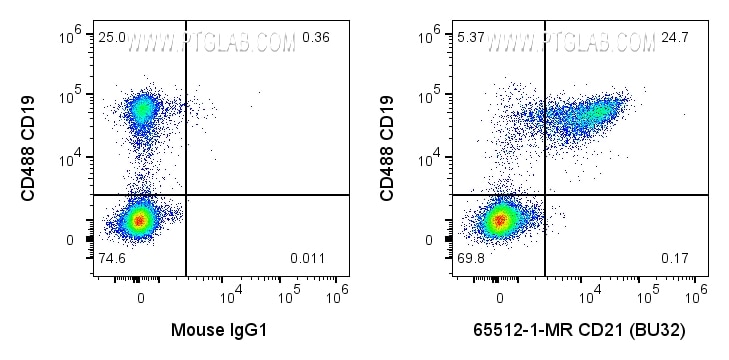Tested Applications
| Positive FC detected in | human PBMCs |
Recommended dilution
| Application | Dilution |
|---|---|
| Flow Cytometry (FC) | FC : 0.1 ug per 10^6 cells in 100 μl suspension |
| This reagent has been tested for flow cytometric analysis. It is recommended that this reagent should be titrated in each testing system to obtain optimal results. | |
Product Information
65512-1-PBS targets CD21 in FC applications and shows reactivity with human samples.
| Tested Reactivity | human |
| Host / Isotype | Mouse / IgG1 |
| Class | Recombinant |
| Type | Antibody |
| Immunogen |
N/A Predict reactive species |
| Full Name | complement component (3d/Epstein Barr virus) receptor 2 |
| Calculated Molecular Weight | 1092 aa, 119 kDa |
| GenBank Accession Number | BC136394 |
| Gene Symbol | CD21 |
| Gene ID (NCBI) | 1380 |
| ENSEMBL Gene ID | ENSG00000117322 |
| Conjugate | Unconjugated |
| Form | Liquid |
| Purification Method | Affinity purification |
| UNIPROT ID | P20023 |
| Storage Buffer | PBS only, pH 7.3. |
| Storage Conditions | Store at -80°C. Stable for one year after shipment. |
Background Information
CD21, also known as complement receptor type 2 (CR2), complement C3d receptor, and Epstein-Barr virus receptor, is a transmembrane protein that contains a small cytoplasmic domain, a transmembrane region and an extracellular domain consisting of 15 tandem short consensus repeat sequences (PMID: 6230668; 2551147). It is expressed on B cells, follicular dendritic cells, thymocytes and a subset of peripheral T cells (PMID: 26119182). CD21 binds complement fragments C3d, C3dg and iC3b and acts as a receptor for the Epstein-Barr virus (PMID: 7753047). On B cells, together with CD19 and CD81, CD21 forms a complex that functions as a co-receptor to the BCR (PMID: 7542009). It is involved in B cells activation and functions.
Protocols
| Product Specific Protocols | |
|---|---|
| FC protocol for CD21 antibody 65512-1-PBS | Download protocol |
| Standard Protocols | |
|---|---|
| Click here to view our Standard Protocols |














